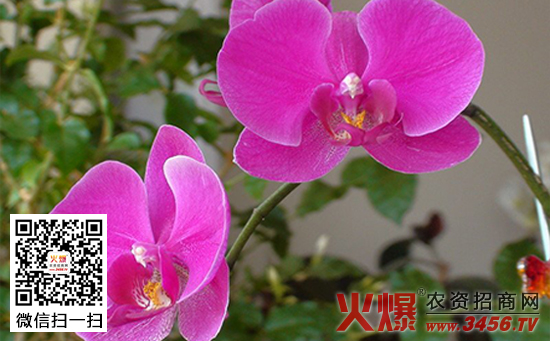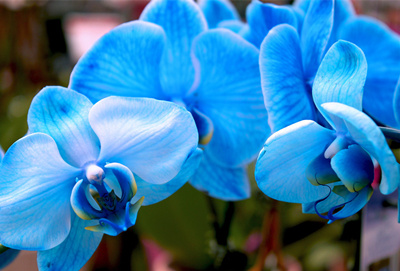Summer Management of Phalaenopsis
Phalaenopsis likes to live in a semi-shady environment with high temperature, high humidity and good ventilation. The most suitable growth temperature is 22-28 degrees Celsius. Too high or low temperature will adversely affect its growth. In summer, the weather is dry and hot, the air temperature often exceeds 32 degrees Celsius, and the air circulation is not good, and the sunlight is strong, which is extremely disadvantageous to the growth of Phalaenopsis, so we should pay attention to the summer management of Phalaenopsis.
Due to improper management in summer, Phalaenopsis is prone to the following problems: 1. The leaves are aging and falling off, the lower leaves of some plants decline during the summer, and gradually yellowing and falling off from the end of summer to autumn.
2. Serious diseases and insect pests, especially hot weather, high air relative humidity, no wind and high temperature, which can easily lead to soft rot, brown spot, virus and other diseases.
Therefore, it is necessary to strengthen the management of Phalaenopsis in summer, especially the problem of cooling. The following measures can be taken:
1. Sunshade. Add a double-layer sunshade net in the place where the Phalaenopsis is placed to reduce the light, which can achieve a good cooling effect (2 ~ 4 degrees Celsius) and prevent the sun from burning the leaves.
2. Ground wine and irrigation. The temperature is high in summer, but the temperature of the water just pumped out of the well is very low, about 16 degrees Celsius. Therefore, the method of drinking or irrigation can play an obvious cooling effect.
3. The cooling rate of foliar spraying is the fastest, but the duration is the shortest.
4. Ventilation. A square hole of-40 cm × 40 cm is drilled at a distance of 70 cm at a distance of 5 meters on the wall to increase ventilation and reduce the occurrence of diseases and insect pests. Turn on the fan above 25 degrees Celsius to strengthen air circulation to facilitate plant growth.

Summer management of Phalaenopsis
When the average temperature is above 18 ℃, the growth activity of Phalaenopsis is the most vigorous, so summer is the fastest growing period. Phalaenopsis grows new leaves from the center of the orchid plant, so it is necessary to always observe whether new leaves grow. Because the growth of new leaves has a lot to do with the period of fertilizer application.
1. Place of placement
Because Phalaenopsis is born in an environment without strong light, it does not like strong sunlight. Therefore, when cultivated in the greenhouse, two layers of shading net should be used, and the shading rate is about 70% to 80%.
Indoor cultivation should also be placed in a well-ventilated place such as a doorway or window, and two curtains should be used to reduce sunlight. Due to high temperature in summer, when growing in a greenhouse, special attention should be paid to ventilation, and exhaust fans can be used to help air circulation.
If you put it outside for cultivation, it is still not suitable to be caught in the rain. But it doesn't matter if the orchid plant planted on the snake board is caught in the rain. Phalaenopsis prefers the growing environment in which the temperature is high during the day and decreases at night. Taiwan has a Pacific island climate, and summer nights are still very muggy, which can easily weaken orchid plants, so special attention should be paid to cultivation.
two。 Watering
High temperature in summer, water can not be condensed on the leaves, so as not to cause leaf burning. Try to keep dry during the rainy season, do not supply too much water. It is easy to dry in the middle of summer, as long as the surface of the plant is dry, it should be watered to help growth. Foliar spray is sometimes applied to increase humidity.
Even if it is planted in a pot of the same size, the number of leaves and roots in each pot are also different, so it is necessary to consider the situation when watering, watering each pot individually.
3. Fertilizer
Summer is the growing period of Phalaenopsis, the application of fertilizer must not be ignored. Use thinner liquid fertilizer 1500 to 2000 times, once a week.
When the leaves began to grow in early summer, the solid organic fertilizer mixed with oil meal and bone meal was applied once a month, but not in the height of summer.
4. Pest control
Phalaenopsis likes the breeze, a little more muggy will suffer from soft rot and black spot disease. Therefore, fungicides should be sprayed to prevent and cure it this season. The best spraying period is when the new leaves begin to grow.
The above is the summer management of Phalaenopsis. Phalaenopsis likes to live in a semi-shady environment with high temperature, high humidity and good ventilation, and the most suitable growth temperature is 22-28 ℃. Too high or too low temperature will adversely affect its growth. In summer, the weather is dry and hot, the air temperature often exceeds 32 ℃, and the air circulation is not good, and the direct sunlight is strong, which is extremely disadvantageous to the growth of Phalaenopsis.
Key points of maintenance and management of white Phalaenopsis in summer
White Phalaenopsis. Phalaenopsis has broad leaves, one to several flower stems are arched, and the flowers are large and shaped like butterflies. They are the treasures of tropical orchids and have the reputation of "queen of orchids".
A variety of colors of Phalaenopsis, it is appropriate to choose white in summer, white for cold tone, looks cool and elegant, tranquil and quiet.
Key points of maintenance:
Phalaenopsis likes shade, the room temperature cannot be too high, likes the ventilated, moist environment, requests the air humidity to always maintain at 60% 80%, and maintains the air circulation, had better have the breeze to blow, avoid the dry hot wind, the basin cannot accumulate water too much.
Summer selection of Phalaenopsis, you can focus on two points, one is to have more buds, and the other is to have thick petals, so that the florescence can be maintained for a long time.
- Prev

What are the key points of Phalaenopsis winter management
Because Phalaenopsis is native to the tropics, it is not resistant to severe cold. When the temperature is too low in winter, if it is not cultivated properly, necrotic black spots will appear on the leaves, and then fall off, resulting in the death of the whole plant. The north needs to be cultivated in high temperature greenhouse in winter, so we specially introduce the key points of its winter management.
- Next

How to raise Phalaenopsis after flowering?
How to raise Phalaenopsis after flowering mainly has two aspects,-whether to cut the flower arrow or not, and how to maintain it after flowering. This paper mainly analyzes how to raise Phalaenopsis after flowering. Do you want to cut the flower arrow after Phalaenopsis blossoms? after Phalaenopsis blossoms, the flower stem can be cut.
Related
- Fuxing push coffee new agricultural production and marketing class: lack of small-scale processing plants
- Jujube rice field leisure farm deep ploughing Yilan for five years to create a space for organic food and play
- Nongyu Farm-A trial of organic papaya for brave women with advanced technology
- Four points for attention in the prevention and control of diseases and insect pests of edible fungi
- How to add nutrient solution to Edible Fungi
- Is there any good way to control edible fungus mites?
- Open Inoculation Technology of Edible Fungi
- Is there any clever way to use fertilizer for edible fungus in winter?
- What agents are used to kill the pathogens of edible fungi in the mushroom shed?
- Rapid drying of Edible Fungi

